Greenhouse farming has gained momentum in many areas in Kenya. That growth can be attributed to many reasons, with increased production being the leading reason. Greenhouse farming is one of the most environmentally friendly methods of agriculture, as it uses a fraction of the land and water needed to produce food than traditional farming. In Kenya, greenhouse farming has been growing in popularity due to the country’s high temperatures and lack of rainfall.
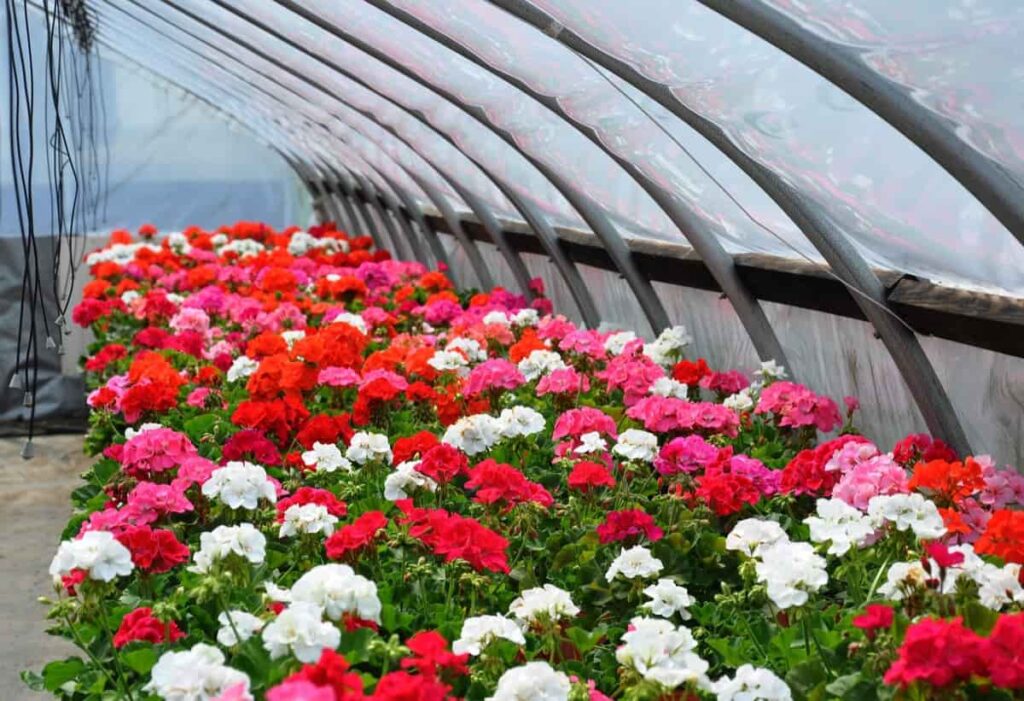
Greenhouse farming in Kenya:
What is greenhouse farming?
It uses a controlled environment to grow plants. It’s a popular method because it allows farmers to produce crops year-round, even in areas with limited sunlight or rainfall. Greenhouse farming is popular in countries with warm climates because it allows crops to be grown year-round. Greenhouse farming is also popular in countries with a long rainy season because it will enable crops to be grown without waiting for rain.
Greenhouse vegetable production in Kenya
Kenya is the world’s fourth-largest producer of greenhouse vegetables, accounting for 1.5 percent of global production. The country has abundant untapped agricultural potential, including temperate and tropical zones with sufficient sunlight and rainfall. As a result, Kenya’s climate is conducive to growing a wide variety of vegetables in greenhouses, including leafy greens, cucumbers, tomatoes, peppers, and aubergines.
To date, the majority of greenhouse vegetable production in Kenya has been concentrated in the coastal region around Mombasa and Nairobi. However, there is a large potential for expansion inland as the country becomes more electrified and road infrastructure improves. There are also opportunities to grow to produce in cold-frame or hoop houses using locally available materials and labor.
The benefits of greenhouse vegetable production in Kenya include increased food security due to reduced reliance on imported crops; reduced environmental impact due to reduced need for land, water, and fertilizer inputs; and increased economic efficiency due to high yields compared with traditional farming methods.
Is greenhouse farming profitable in Kenya?
Greenhouse farming is a growing industry in Kenya and has several benefits. Firstly, greenhouse farming is climate-friendly, which helps mitigate the effects of climate change. Second, greenhouse farming is efficient; it uses less land and resources than traditional agriculture methods. Third, greenhouse farming produces high-quality products; crops grown in greenhouses are often larger and more succulent than other farms.
In case you missed it: Greenhouse Farming in the Philippines: How to Start, Agriculture Crops, and Cost to Build
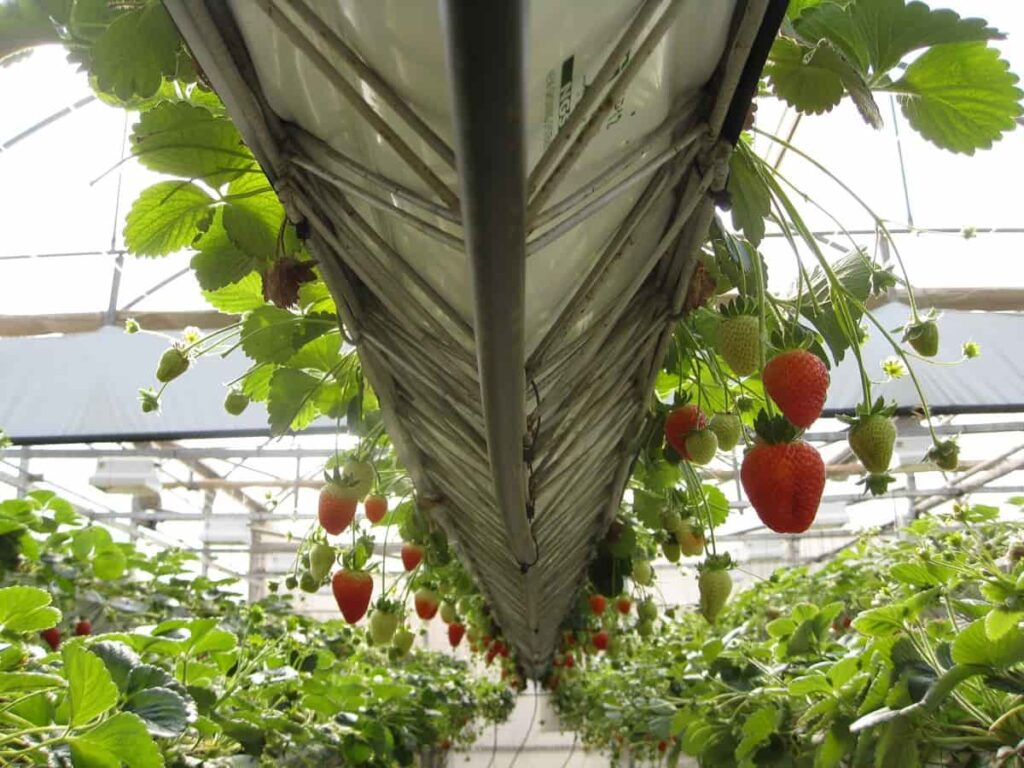
Fourth, greenhouse farming generates new jobs; they typically need minimal training to operate their businesses. Fifth, greenhouse farming can be profitable; in fact, many Kenyan greenhouse farmers earn an income better than average wage earners in the country. Finally, greenhouse farming is environmentally friendly; as with all forms of agriculture, greenhouse farming requires minimal inputs (water, fertilizer, etc.) and produces little pollution.
Top states for greenhouse farming in Kenya
Kenya has several advantages for greenhouse farming, including ample sunlight and relatively cool temperatures. The country also has fertile soil and plenty of water. As a result, greenhouse farming can be successfully conducted in several locations in Kenya, including the highlands, coastal areas, and arid zones. Greenhouse farming is possible in Kenya with its abundant fertile land and temperate maritime climate. Kenya’s three most important greenhouse farming areas are Kilifi, Mombasa, and Kwale.
Kilifi is located in the Eastern Province and has a mild climate that is perfect for growing tomatoes, cucumbers, bell peppers, and other tropical fruits. The area has plenty of sunlight and access to fresh water. Mombasa is located on the coast of Kenya and has a warm climate that is ideal for growing strawberries, grapes, and other tropical fruits. The area has access to seawater and ample sunlight. Kwale is located in the Western Province and has a cooler climate best suited for growing flowers such as roses, lilies, or tulips. The area also has access to freshwater resources.
Crops are grown under greenhouses in Kenya
Greenhouses use artificial cooling to maintain optimum growing conditions year-round. The main greenhouse crops in Kenya are Tomatoes, Cucumbers, flowers such as Roses and Orchids, and leafy greens such as Kale. The main crops that can be grown in greenhouses are tomatoes, cucumbers, beans, flowers, and vegetables. Greenhouses also help to protect plants from extreme weather conditions. Some of the vegetables you can expect to find in a Kenyan greenhouse include:
| Tomatoes | Bush Tomatoes |
| Grapefruit | Lettuce |
| Peppers | Brussels sprouts |
| Cucumbers | Cauliflower |
| Watermelon |
What are the different greenhouse farm types in Kenya?
- Open-air greenhouses rely on the sun’s energy to heat the greenhouse and provide light. They are inexpensive to build but require regular attention to ensure consistent temperature and humidity.
- Rigid-frame greenhouses are made from heavy steel frames covered with plastic or glass sheets. They offer better insulation and protection from the elements than open-air greenhouses, but they can be more expensive to construct.
- Tented greenhouses rely on a series of small hinged panels that can control the amount of light in the greenhouse. They are more expensive than open-air or rigid-frame greenhouses but offer better insulation, protection from weather conditions, and easier access to plants.
- The hoop greenhouse is similar to the cold frame system but has a series of hoops that help retain heat and keep the plants close to the ground. This type of greenhouse is better suited for larger plots of land because it produces more fruit and vegetables than the cold frame system.
- The polytunnel is a type of greenhouse that uses underground pipes to transport sunlight directly to the plants. This system is expensive to set up, but it’s one of the most efficient ways to grow crops.
In case you missed it: 16 Key Rules for Effective Greenhouse Farm Management: From Planning to Reducing Production Cost
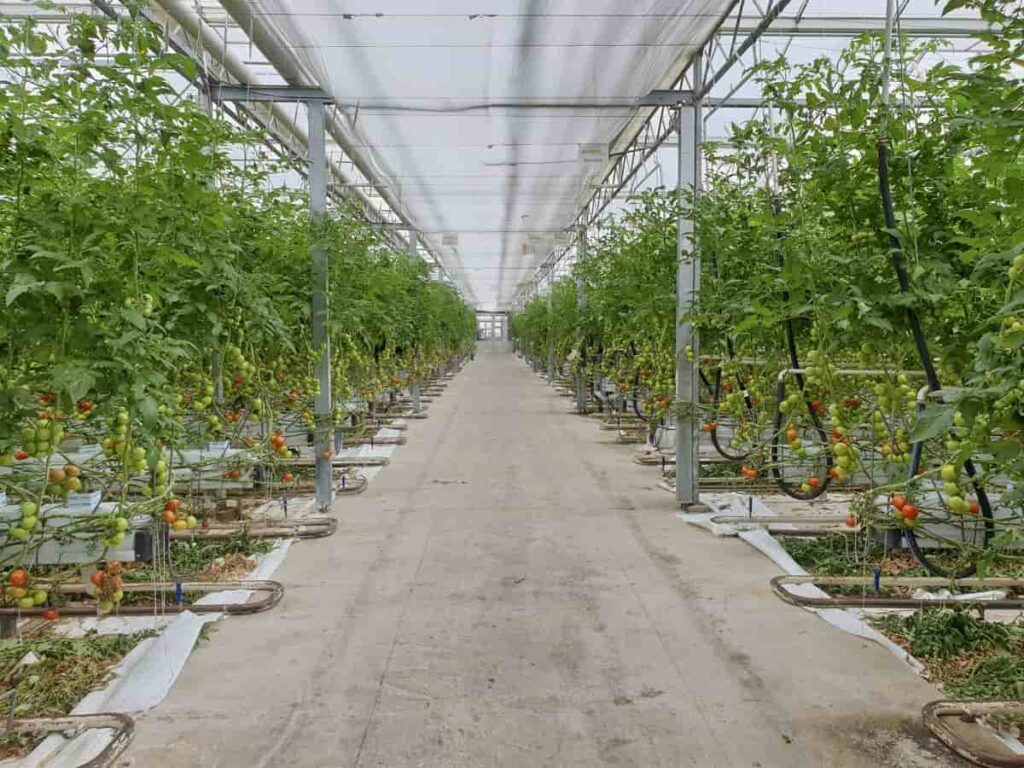
Setting up a greenhouse in Kenya
- Setting up a greenhouse in Kenya can provide you with many benefits. Firstly, the temperature inside a greenhouse is much hotter than outside, so you can grow plants more quickly and with less water. This is especially useful in areas where there is a shortage of water.
- Secondly, greenhouses provide an ideal environment for growing fruit and vegetables. They can protect plants from extreme weather conditions, such as strong sunlight or wind. This means your product will be fresh and healthy when it arrives at your doorstep.
- Lastly, greenhouses are excellent sources of income. You can charge people for access to the greenhouse or sell products directly to consumers. Greenhouse farming in Kenya can be very profitable if you have the proper setup and know what you’re doing.
Cost to start a greenhouse farm in Kenya
To set up a greenhouse farm in Kenya, one can expect to spend between $4,000 and $8,000. Food costs will be high, as will the cost of labor. However, there are many ways to offset these costs. For example, one could start by leasing land from a local farmer or government body and purchasing needed equipment and supplies.
Number of greenhouses in Kenya
Kenya is home to the world’s second-largest producer of horticultural products after China. The country has an estimated 1,100 greenhouses, with a production capacity of 575 million square feet (53 million square meters). Kenya is the leading producer of tomatoes, peppers, cucumbers, eggplants, and sweet potatoes.
Tips on build greenhouse farming in Kenya
Select the Location
The first step in building a greenhouse in Kenya is selecting a suitable location. The location should be sunny, dry, and ventilated. It is also important to choose a site that can accommodate the size and shape of the greenhouse. First, make sure to have the right space. For example, a small greenhouse can fit on a single-acre plot, while a larger one may require more land.
Construct the Structure
The next step is to construct the structure of the greenhouse. The structure should be sturdy enough to support the weight of the roof and walls. The walls should also be insulated so that heat can be trapped inside the greenhouse during cold weather. Windows can be installed on either side of the structure for ventilation purposes.
A frame structure can be cheaply constructed and easy to move if you decide to expand your operation later. However, sheet glass cannot be moved quickly and may require special construction techniques if you want to enlarge or change the layout of your greenhouse. A portable hoop frame structure is also an option but is more expensive and requires less construction time.
In case you missed it: How to Water Your Garden with Solar Power: For Home Gardening, Greenhouse, Polyhouse, and Outdoor
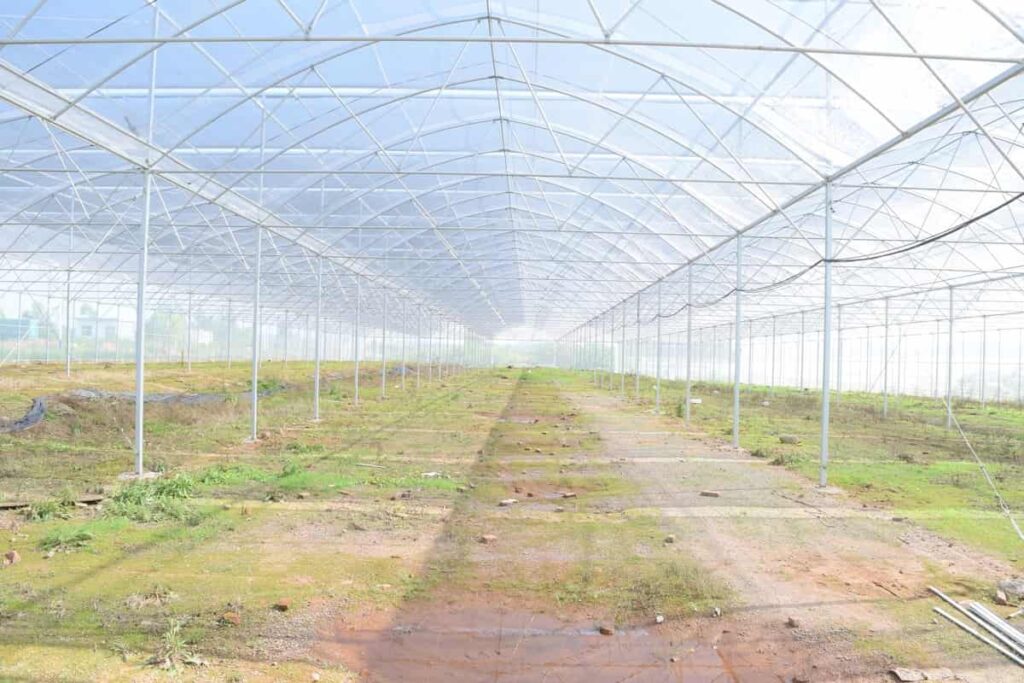
Ventilation for your plants
Finally, ensure enough ventilation for your plants. Greenhouse farming is not ideal for plants that need high humidity levels (like flowers) or those that prefer closed environments (like trees). Farmers must take care when constructing greenhouses to protect plants from wind and rain damage. To do this, they should install proper ventilation systems and screen windows to keep out insects and birds.
Greenhouse subsidy in Kenya
Kenya is in the midst of an agricultural revolution as farmers turn to greenhouse farming to increase production. A subsidy program provides incentives for farmers to convert their land to greenhouse farming, and the program has been a success so far. The Kenyan government has instituted a subsidy program incentivizes farmers to convert their land to greenhouse farming.
The goal of the subsidy is twofold: first, it seeks to increase production by encouraging the adoption of more efficient farming techniques; second, it aims to reduce the country’s dependence on expensive foreign inputs. To date, the program has been successful. Greenhouse farming has increased crop yields by up to 50% and reduced reliance on expensive foreign inputs by up to 60%. This helps Kenya achieve food security and improves environmental sustainability by reducing reliance on polluting energy sources.
Challenges of greenhouse farming in Kenya
Some challenges must be faced when managing a greenhouse farm in Kenya. One challenge is that there is limited space available for greenhouses on farms. Another challenge is that few skilled workers can operate greenhouses well. However, these challenges can be overcome by training people who live in rural areas on how to manage greenhouses effectively. Greenhouse farming in Kenya faces several challenges, some stemming from the country’s unique climate and soil composition, while others are inherent in greenhouse farming.
For example, Kenya suffers from very high variations in temperature and rainfall, making it difficult to ensure consistent growth conditions for plants. Additionally, the country is prone to natural disasters such as droughts and floods, which can damage or destroy greenhouse structures. And finally, there is a lack of reliable infrastructure to support large-scale greenhouse farming operations.
In case you missed it: Top 22 Succulents to Grow at Home: in Pots, Indoors, Greenhouse, Problems, and Care
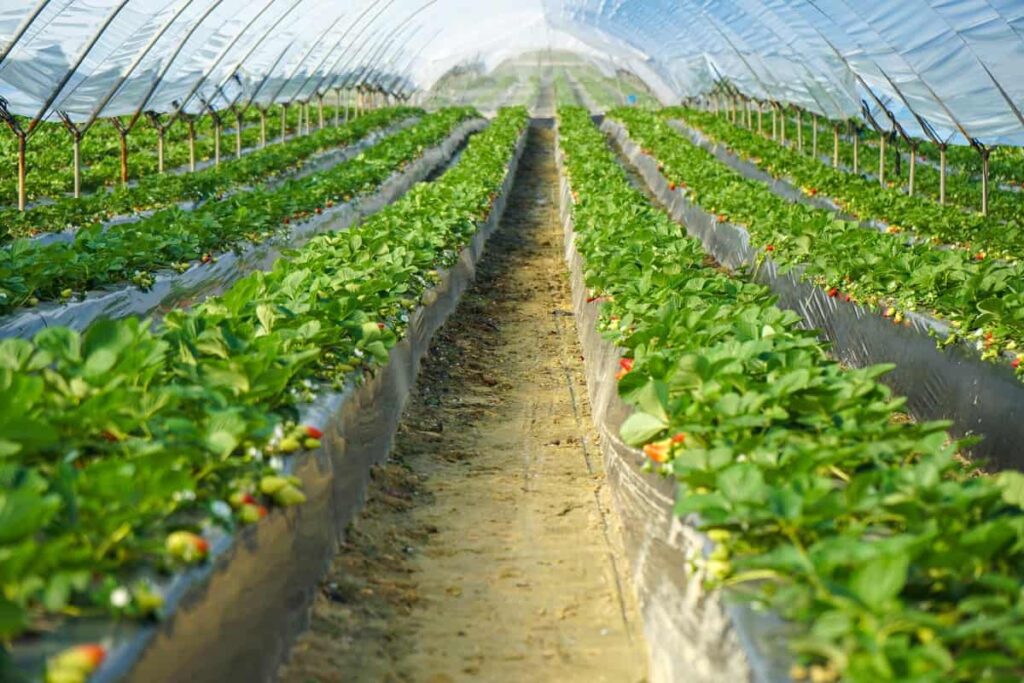
The main challenges faced by farmers in greenhouse cultivation include the following:
- Lack of experience: Most farmers are not used to growing crops under glass, so it takes some time to get a good yield from their plants.
- Low yields: Greenhouse farmers typically achieve lower yields than traditional farmers because they have to compensate for the lack of sunlight and warmth in the environment.
- High costs: The high cost of inputs, such as fertilizer and water, makes greenhouse farming an expensive proposition for small-scale farmers.
- Limited space: A limited amount of land can be used to cultivate plants in a greenhouse, which poses a challenge for small-scale farmers who want to grow high-value crops.
Despite these challenges, greenhouse farmers in Kenya are making significant strides in developing sustainable greenhouses that can produce fruit and vegetables locally and improve food security for the population.
Organic greenhouse farming in Kenya
- Kenya is the most important country in Africa for organic greenhouse farming. This is because Kenya has a long history of agriculture, and its soil is well-suited to organic farming. The country also has a warm climate, which allows for year-round gardening.
- The Kenyan government supports organic greenhouse farming through subsidies and other incentives. In addition, the country has several universities that teach organic gardening, so a skilled workforce is already available to start businesses in this field.
- There are two main types of organic greenhouse farming in Kenya: cattle-based and fruit-based. Cattle-based greenhouses use manure to fertilize crops, while fruit-based greenhouses use compost and water to hydrate plants.
- The benefits of using organic methods in agriculture are clear: sustainable practices produce healthier food, help prevent deforestation, and reduce pollution. Organic greenhouse farming in Kenya offers an exciting new opportunity for local farmers to prosper while helping to protect our environment.
Factors affecting greenhouse farming in Kenya
Many factors affect greenhouse farming in Kenya, including climate and soil conditions. The Kenyan climate is tropical, with a very warm year-round temperature range. As a result, the country has a relatively short rainy season, with heavy rains falling between May and October. As a result, water is scarce most of the year and must be carefully managed on farms.
In addition to being moisture-scarce, Kenya has high variability in rainfall; some years may receive only 60 mm, while others may receive up to 1,000 mm. Soil conditions in Kenya are also important for greenhouse farming. Most of the country’s soils are sandy or gravelly, which can be difficult to irrigate and maintain low acidity levels. Furthermore, these soils are also subject to erosion and landslides during rainy seasons.
To combat these issues, farmers must use a variety of techniques to improve soil fertility and drainage: they may build terraces or levees to increase soil retention, install raised beds or swales, or use contour plowing or contour planting methods that direct water away from the edge of fields into deeper soil layers.
Management of pests and diseases in greenhouse farming in Kenya
Managing pests and diseases in greenhouse farming in Kenya is a critical aspect of production. Greenhouse operators must be aware of the potential for these pests and diseases and implement effective control measures when they arise.
Greenhouse growers should use several strategies to prevent or reduce the spread of pests and diseases, including using resistant varieties, proper crop rotation, and rigorous cleanliness procedures. In addition, pre-harvest treatment with Bacillus thuringiensis (Bt) effectively controls certain insect pests.
In case you missed it: Growing Broccoli in Greenhouse – Planting, Farming
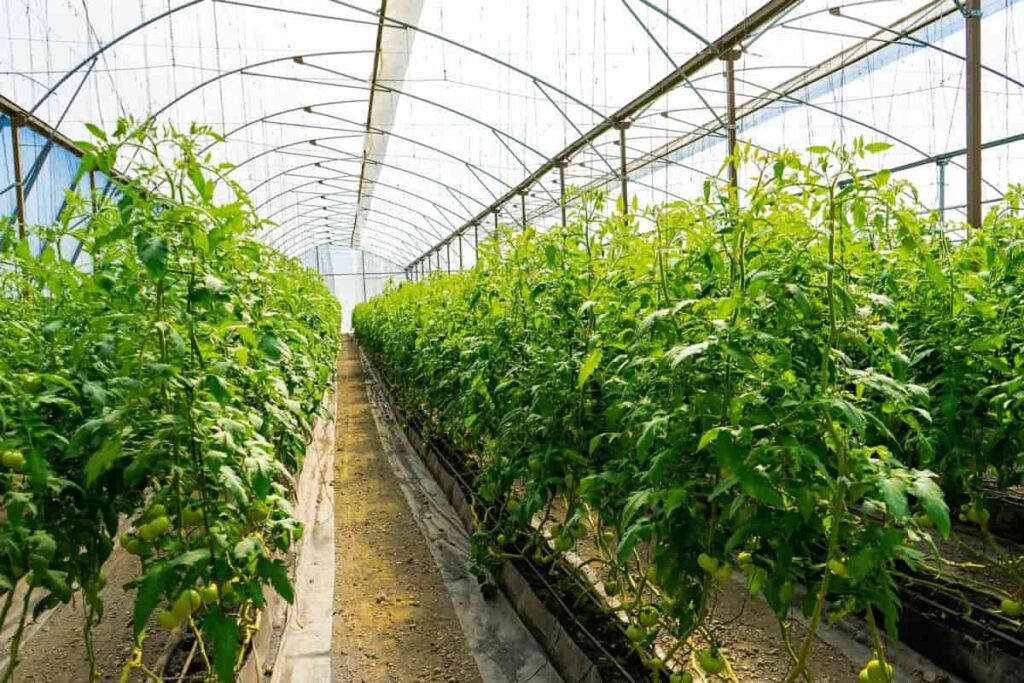
Greenhouse construction in Kenya
It involves constructing both wooden and metallic greenhouses for crop production. Kenya has a warm and wet climate that is perfect for horticulture production. In addition, the country is endowed with a rich diversity of soils, climatic conditions, vegetation, and human resources suited to growing temperate crops such as fruits and vegetables in greenhouses.
Greenhouse construction in Kenya starts by choosing the right site for the greenhouse. The location should be sunny but well-ventilated, have good soil fertility, and adequate water supply. Once the site is chosen, a preliminary survey should be done to determine the size and layout of the greenhouse space. Then, a combination of building materials like bamboo or plastic sheeting can be used to construct the greenhouse.
Once erecting the structure, it needs to be adequately insulated using fiberglass or mineral wool insulation. The roof should also be covered with appropriate material to protect it from direct sunlight and rain. Greenhouses need regular maintenance to ensure their long-term effectiveness; this includes watering plants, checking insulation levels, and replacing defective components.
Conclusion
Greenhouse farming can help increase yields by up to 50%. This is because greenhouse farming allows farmers to control the environment inside the farm, which in turn better regulates the temperature and humidity levels, thus leading to increased crop production. Kenya has a warm and wet climate that is perfect for greenhouse farming. The country also has a large agricultural land area, making it an ideal location for growing crops in greenhouses.
- Types of Pesticides Used in Agriculture: A Beginner’s Guide
- Economical Aquaculture: A Guide to Low-Budget Fish Farming
- 15 Common Planting Errors That Can Doom Your Fruit Trees
- How to Make Houseplants Bushy: Effective Tips and Ideas
- Innovative Strategies for Boosting Coconut Pollination and Yield
- Pollination Strategies for Maximum Pumpkin Yield
- The Complete Guide to Chicken Fattening: Strategies for Maximum Growth
- Natural Solutions for Tulip Problems: 100% Effective Remedies for Leaf and Bulb-Related Issues
- Revolutionizing Citrus Preservation: Towards a Healthier, Greener Future
- Natural Solutions for Peony Leaf and Flower Problems: 100% Effective Remedies
- Maximizing Profits with Avocado Contract Farming in India: A Comprehensive Guide
- Natural Solutions for Hydrangea Problems: 100% Effective Remedies for Leaf and Flowers
- The Ultimate Guide to Choosing the Perfect Foliage Friend: Bringing Life Indoors
- From Sunlight to Sustainability: 15 Ways to Use Solar Technology in Agriculture
- The Ultimate Guide to Dong Tao Chicken: Exploring from History to Raising
- The Eco-Friendly Makeover: How to Convert Your Unused Swimming Pool into a Fish Pond
- Mastering the Art of Delaware Chicken Farming: Essentials for Healthy Backyard Flocks
- 20 Best Homemade Fertilizers for Money Plant: DIY Recipes and Application Methods
- How to Craft a Comprehensive Free-Range Chicken Farming Business Plan
- Brighten Your Flock: Raising Easter Egger Chickens for Beauty and Bounty
- How to Optimize Your Poultry Egg Farm Business Plan with These Strategies
- Subsidy for Spirulina Cultivation: How Indian Government Schemes Encouraging Spirulina Farmers
- Ultimate Guide to Raising Dominique Chickens: Breeding, Feeding, Egg-Production, and Care
- Mastering the Art of Raising Jersey Giant Chickens: Care, Feeding, and More
- Ultimate Guide to Raising Legbar Chickens: Breeding, Farming Practices, Diet, Egg-Production
- How to Raise Welsummer Chickens: A Comprehensive Guide for Beginners
- How to Protect Indoor Plants in Winter: A Comprehensive Guide
- Ultimate Guide to Grow Bag Gardening: Tips, Tricks, and Planting Ideas for Urban Gardeners
- Guide to Lotus Cultivation: How to Propagate, Plant, Grow, Care, Cost, and Profit
- Agriculture Drone Subsidy Scheme: Government Kisan Subsidy, License, and How to Apply Online
- Ultimate Guide to Raising Araucana Chickens: Breed Profile, Farming Economics, Diet, and Care
- Bringing Hydroponics to Classroom: Importance, Benefits of Learning for School Students
- Ultimate Guide to Raising Polish Chickens: Breed Profile, Farming Economics, Diet, and Care
- Ultimate Guide to Raising Australorp Chickens: Profile, Farming Economics, Egg Production, Diet, and Care
- Silkie Chicken Farming: Raising Practices, Varieties, Egg Production, Diet, and Care
- Sussex Chicken Farming: Raising Practices, Varieties, Egg Production, Diet and Care